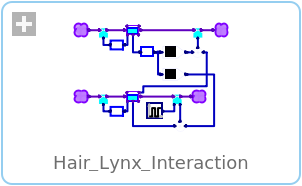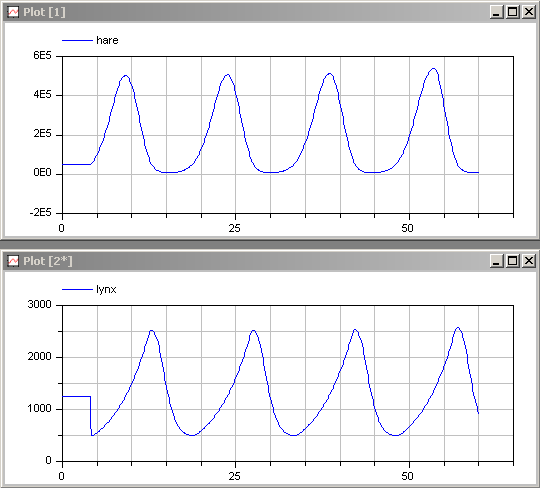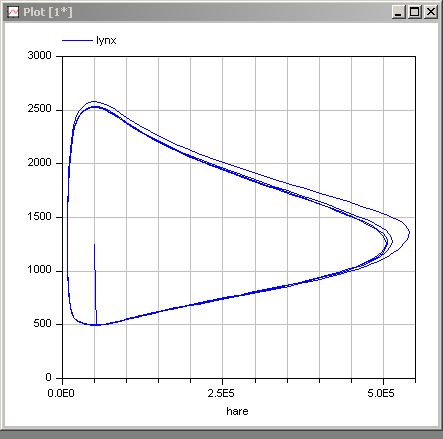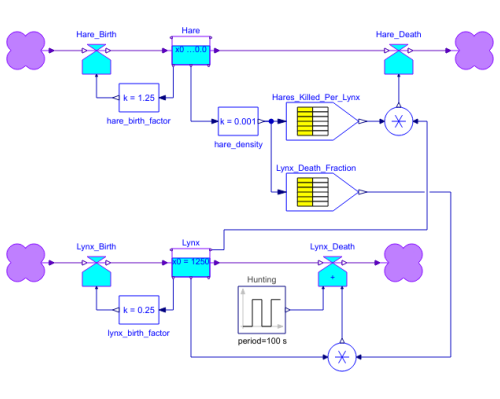WOLFRAM SYSTEM MODELER
Hair_Lynx_InteractionPredator/prey model |
|
Diagram
Wolfram Language
SystemModel["SystemDynamics.IntroductoryExamples.Hair_Lynx_Interaction"]

Information
References:
- Richmond, B., S. Peterson, and P. Vescuso (1987), An Academic User's Guide to STELLA, High Performance Systems, Inc., Lyme, N.H.
Simulate the model across 60 time units and plot the two animal populations against simulation time:

You need to reduce the accuracy to 1e-10 in order for the simulation to run correctly.
Also plot the two population against each other:

You shall notice that the limit cycle is mildly unstable.
The simulation results obtained are not exactly the same as with SystemDynamics 1.0. The reason is that the previous version used tabular interpolation functions with linear extrapolation, whereas the new version uses tabular interpolation functions without extrapolation capability (a more prudent approach). In line with STELLA philosophy, the support values of the two tabular functions were manually extended to reflect a constant rather than a linear extrapolation.
Outputs (2)
| hare |
Type: Real Description: Hare population |
|---|---|
| lynx |
Type: Real Description: Lynx population |
Components (18)
| Hare |
Type: Level Description: General System Dynamics level |
|
|---|---|---|
| Hare_Birth |
Type: Rate_1 Description: Unrestricted rate element with one influencing variable |
|
| hare_birth_factor |
Type: Gain Description: Gain factor |
|
| Source1 |
Type: Source Description: This is the (dummy) source model of System Dynamics |
|
| hare_density |
Type: Gain Description: Gain factor |
|
| Hares_Killed_Per_Lynx |
Type: Tabular Description: Tabular function |
|
| Hare_Death |
Type: Rate_1 Description: Unrestricted rate element with one influencing variable |
|
| Sink1 |
Type: Sink Description: This is the (dummy) sink model of System Dynamics |
|
| Lynx |
Type: Level Description: General System Dynamics level |
|
| Lynx_Birth |
Type: Rate_1 Description: Unrestricted rate element with one influencing variable |
|
| lynx_birth_factor |
Type: Gain Description: Gain factor |
|
| Source2 |
Type: Source Description: This is the (dummy) source model of System Dynamics |
|
| Lynx_Death |
Type: Rate_2 Description: Unrestricted additive rate element with two influencing variables |
|
| prod_2_1 |
Type: Prod_2 Description: Product of two influencing factors |
|
| Lynx_Death_Fraction |
Type: Tabular Description: Tabular function |
|
| Sink2 |
Type: Sink Description: This is the (dummy) sink model of System Dynamics |
|
| Hunting |
Type: Pulse Description: Generate pulse signal of type Real |
|
| prod_2_2 |
Type: Prod_2 Description: Product of two influencing factors |

